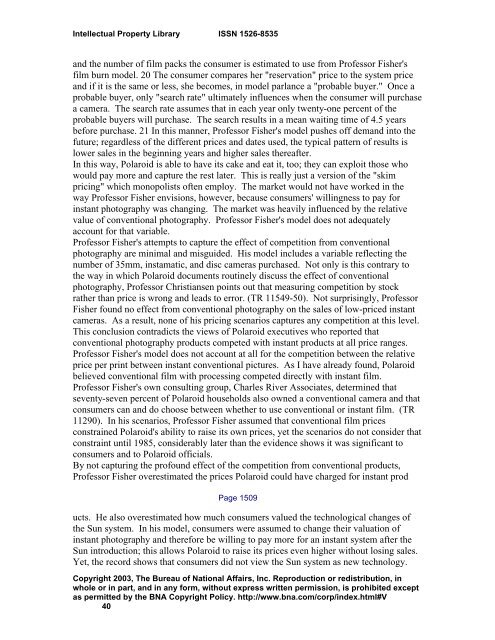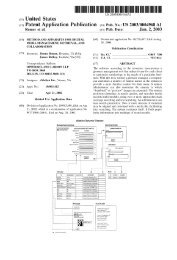Polaroid Corp. v. Eastman Kodak Co. - Oppedahl Patent Law Firm LLC
Polaroid Corp. v. Eastman Kodak Co. - Oppedahl Patent Law Firm LLC
Polaroid Corp. v. Eastman Kodak Co. - Oppedahl Patent Law Firm LLC
Create successful ePaper yourself
Turn your PDF publications into a flip-book with our unique Google optimized e-Paper software.
Intellectual Property Library ISSN 1526-8535<br />
and the number of film packs the consumer is estimated to use from Professor Fisher's<br />
film burn model. 20 The consumer compares her "reservation" price to the system price<br />
and if it is the same or less, she becomes, in model parlance a "probable buyer." Once a<br />
probable buyer, only "search rate" ultimately influences when the consumer will purchase<br />
a camera. The search rate assumes that in each year only twenty-one percent of the<br />
probable buyers will purchase. The search results in a mean waiting time of 4.5 years<br />
before purchase. 21 In this manner, Professor Fisher's model pushes off demand into the<br />
future; regardless of the different prices and dates used, the typical pattern of results is<br />
lower sales in the beginning years and higher sales thereafter.<br />
In this way, <strong>Polaroid</strong> is able to have its cake and eat it, too; they can exploit those who<br />
would pay more and capture the rest later. This is really just a version of the "skim<br />
pricing" which monopolists often employ. The market would not have worked in the<br />
way Professor Fisher envisions, however, because consumers' willingness to pay for<br />
instant photography was changing. The market was heavily influenced by the relative<br />
value of conventional photography. Professor Fisher's model does not adequately<br />
account for that variable.<br />
Professor Fisher's attempts to capture the effect of competition from conventional<br />
photography are minimal and misguided. His model includes a variable reflecting the<br />
number of 35mm, instamatic, and disc cameras purchased. Not only is this contrary to<br />
the way in which <strong>Polaroid</strong> documents routinely discuss the effect of conventional<br />
photography, Professor Christiansen points out that measuring competition by stock<br />
rather than price is wrong and leads to error. (TR 11549-50). Not surprisingly, Professor<br />
Fisher found no effect from conventional photography on the sales of low-priced instant<br />
cameras. As a result, none of his pricing scenarios captures any competition at this level.<br />
This conclusion contradicts the views of <strong>Polaroid</strong> executives who reported that<br />
conventional photography products competed with instant products at all price ranges.<br />
Professor Fisher's model does not account at all for the competition between the relative<br />
price per print between instant conventional pictures. As I have already found, <strong>Polaroid</strong><br />
believed conventional film with processing competed directly with instant film.<br />
Professor Fisher's own consulting group, Charles River Associates, determined that<br />
seventy-seven percent of <strong>Polaroid</strong> households also owned a conventional camera and that<br />
consumers can and do choose between whether to use conventional or instant film. (TR<br />
11290). In his scenarios, Professor Fisher assumed that conventional film prices<br />
constrained <strong>Polaroid</strong>'s ability to raise its own prices, yet the scenarios do not consider that<br />
constraint until 1985, considerably later than the evidence shows it was significant to<br />
consumers and to <strong>Polaroid</strong> officials.<br />
By not capturing the profound effect of the competition from conventional products,<br />
Professor Fisher overestimated the prices <strong>Polaroid</strong> could have charged for instant prod<br />
Page 1509<br />
ucts. He also overestimated how much consumers valued the technological changes of<br />
the Sun system. In his model, consumers were assumed to change their valuation of<br />
instant photography and therefore be willing to pay more for an instant system after the<br />
Sun introduction; this allows <strong>Polaroid</strong> to raise its prices even higher without losing sales.<br />
Yet, the record shows that consumers did not view the Sun system as new technology.<br />
<strong>Co</strong>pyright 2003, The Bureau of National Affairs, Inc. Reproduction or redistribution, in<br />
whole or in part, and in any form, without express written permission, is prohibited except<br />
as permitted by the BNA <strong>Co</strong>pyright Policy. http://www.bna.com/corp/index.html#V<br />
40





